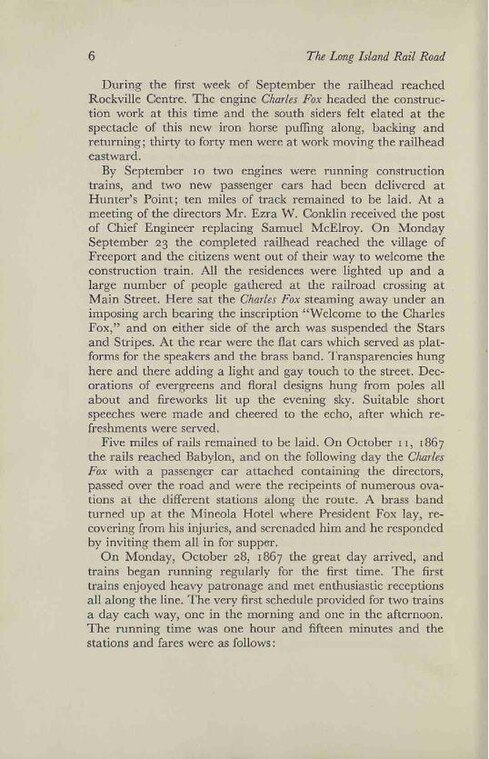During the first week of September the railhead reached Rockville Centre. The engine Charles Fox headed the construction work at this time and the south siders felt elated at the spectacle of this new iron horse puffing along, backing and returning; thirty to forty men were at work moving the railhead eastward.
By September 10 two engines were running construction trains, and two new passenger cars had been delivered at Hunter's Point; ten miles of track remained to be laid. At a meeting of the directors Mr. Ezra W. Conklin received the post of Chief Engineer replacing Samuel McElroy. On Monday September 23 the completed railhead reached the village of Freeport and the citizens went out of their way to welcome the construction train. All the residences were lighted up and a large number of people gathered at the railroad crossing at Main Street. Here sat the Charles Fox steaming away under an imposing arch bearing the inscription "Welcome to the Charles Fox," and on either side of the arch was suspended the Stars and Stripes. At the rear were the flat cars which served as platforms for the speakers and the brass band. Transparencies hung here and there adding a light and gay touch to the street. Decorations of evergreens and floral designs hung from poles all about and fireworks lit up the evening sky. Suitable short speeches were made and cheered to the echo, after which refreshments were served.
Five miles of rails remained to be laid. On October 11, 1867 the rails reached Babylon, and on the following day the Charles Fox with a passenger car attached containing the directors, passed over the road and were the recipeints of numerous ovations at the different stations along the route. A brass band turned up at the Mineola Hotel where President Fox lay, recovering from his injuries, and serenaded him and he responded by inviting them all in for supper.
On Monday, October 28, 1867 the great day arrived, and trains began running regularly for the first time. The first trains enjoyed heavy patronage and met enthusiastic receptions all along the line. The very first schedule provided for two trains a day each way, one in the morning and one in the afternoon. The running time was one hour and fifteen minutes and the stations and fares were as follows:
